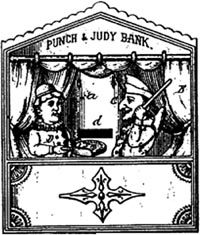By Anne Cartwright

From 1882 to 1892, they produced cast iron still and mechanical banks based on patents held by Charles G. Shepard and Peter Adams, Jr. The latter always reassigned his rights to Walter J. Shepard. The Shepard Hardware Co, remained in business after 1892 when the mechanical bank business was sold to J. & E. Stevens Co., Cromwell CT.
All-Fair Toys & Games; 1926-1952
Harry O. Alderman and Elmer E. Fairchild were cofounders of the Alderman, Fairchild Company of Rochester NY in 1900. The company manufactured paper boxes and novelties. Elmer E. Fairchild held a number of patents related to the paper and novelty industry. When the market for paper boxes dropped, they switched their printing presses designed for color lithography over to the production of games and paper litho on wood toys. Board games and target games were being advertised and sold under the name All-Fair as early as 1922 (Auto Race Game). In 1926, All-Fair spun off as a separate company and moved to Churchville NY, some 59 miles east of Buffalo.
Brice Toy and Novelty Company; 1947-1952
When Herman Guy Fisher left All-Fair to start Fisher-Price in 1930, Jesse Brice along with a few others joined him. In 1947, Jesse Brice left Fisher-Price to start his own company, first in Colden NY (about 25 miles SE of Buffalo), making wooden toys similar to those of All-Fair and Fisher-Price. Part of the success of this company was its licensing of the Warner Brothers cartoon characters, Bugs Bunny, Porky Pig, Daffy Duck, Elmer Fudd and others. The company later moved 20 miles east of Buffalo to East Aurora NY, the same community where Fisher-Price was located. Brice Toy and Novelty Co. was sold in 1952 and renamed the East Aurora Toy Corporation (E. A. T.).
East Aurora Toy Corporation (E. A. T.); 1953-1955
In 1952, Albert Wallenwein, then treasurer of the Brice Toy and Novelty Company, bought the company from Jesse Brice. He renamed it the East Aurora Toy Corporation and the company continued producing wooden toys similar to, or even identical to those of the Brice company. The company closed in the mid Ô50s. Supposedly, Herman Fisher bought up all their tools and materials so others couldn’t compete.
Fisher-Price Toy Company; 1930 to Present
Herman Guy Fisher’s road to Fisher-Price started with the Alderman, Fairchild Company of Rochester NY in sales promotion and games advertising. In 1926, when the toy and game division spun off, Fisher went along as the vice president and general manager of All-Fair. In 1930, he wanted his own toy company and tried to buy All-Fair. Unsuccessful at this he joined with three others to start the Fisher-Price Toy Company.
The other half of the company’s name belonged to Irving R. Price who in 1930 was mayor of East Aurora NY and was trying to establish new businesses in the town. His wife, Margaret Evans Price, a well established artist and illustrator/author of children’s books became the first art director for the new toy company. The last member of the team was Helen M. Schelle, who had been the owner and manager of the Penny Walker Toy Shop in Binghamton NY. She brought her knowledge and connections with the toy industry to the company. As the silent partner in the company she served as the company’s secretary and treasurer.
Margaret Price and Shelle worked together to design the first Fisher-Price toys. The following year, 1931, Fisher Price took 16 brightly colored paper litho on wood “hopefulls” to the American International Toy Fair in New York City. The first Fisher-Price toy ever sold was “Dr. Doodle” in 1931. By 1932 they had toys for sale in Macy’s Department Store and that same year Herman Fisher gained controlling interest in Fisher-Price.
Since then well over five thousand different toys have been released under the Fisher-Price name. The licensed Disney character (Mickey Mouse Band) first appeared in 1935 as well as the popular King Feature’s Syndicate, Popeye; plastic parts first appeared in 1950 (Buzzy Bee). The original logo was changed in 1956 and electronic toys made their appearance in 1980. Herman Fisher retired in 1969 and the Quaker Oats Company bought Fisher-Price. Quaker Oats spun off Fisher-Price as an independent company. In 1993, Mattel bought Fisher-Price. The company is still highly successful.
